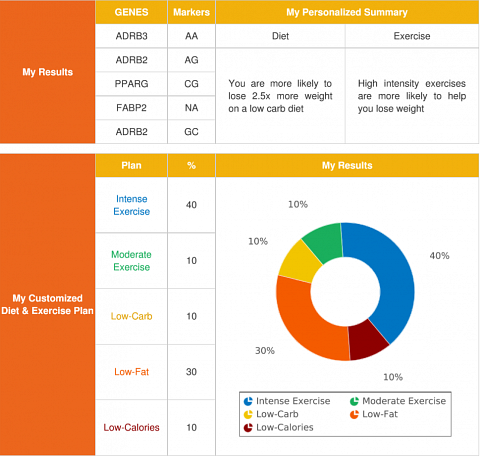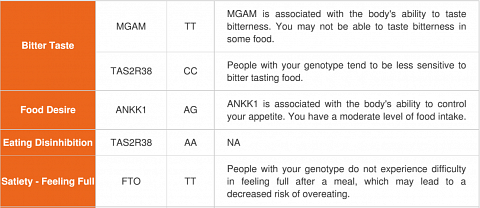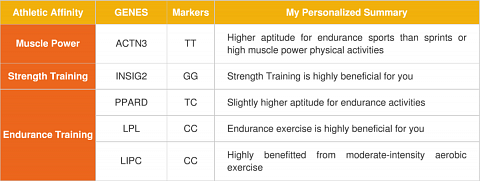At a Glance
Summary
I found the diet and fitness report from LifeDNA to be comprehensive, interesting, and easy to digest. In addition to breaking down my nutritional needs and the benefits I could gain from different types of exercise, I was given two main diet and fitness goals to focus on: sticking to a low-fat diet, and engaging in high intensity workouts. Even if I didn’t follow all the smaller recommendations, having these two goals gave me something to work on that wasn’t too overwhelming.
I received a breakdown of the nutrients that would be included in my supplements, which compared my recommended intakes to the general recommendation. This made me confident that they had been truly tailored to me, and gave me an idea of what I could anticipate from my personalized supplement regime.
The reports also included an ancestry analysis. This was not very clear or comprehensive, and seemed like an add-on to the more comprehensive and specialized health analyses.
(This review will be updated once my genetically-tailored supplements have been received. Please bear in mind this review was written for the ‘LifeDNA Dynamic Pack’, and that the LifeDNA 'Health and Wellness Optimization Program' is for a limited number of people, and subject to application.)
Full Review
LifeDNA is a nutrigenomics company founded in 2017 by C.E.O. Cyril Moukarzel. The company is based in Hawaii, and uses a combination of genomic analysis and self-reported lifestyle information in order to create tailored supplement regimes and diet and fitness reports. By using personalized healthcare, they hope to help individuals optimize their energy levels and live the healthiest life they can.
Product Expectations
The LifeDNA website was clean, stylish, and full of information. They specialized in genetically-tailored skincare and supplements, and I saw that they had used over 1,100 studies and targeted more than 100 genetic “clues” in order to analyze DNA to create their reports and products.
I was to order the ‘LifeDNA Dynamic Pack’, which would include a monthly subscription of five different supplements, as well as a diet and fitness report and nutritional recommendations. To find out more about it, I went to the “Supplements” page on the LifeDNA website.
Here, I read that generic supplements are not specific enough for my individual needs. I may have vitamin and mineral deficiencies that are genetic, or have difficulty absorbing certain nutrients. My genetics could predispose me to certain conditions, or even cause me to have trouble losing weight.
I read that LifeDNA followed Good Manufacturing Practices (GMP) when creating their supplements. They sourced the best natural and synthesized ingredients available, unlike cheap generic supplements, which often contain excess chemicals, fillers, and additives. When testing the purity of their supplements, LifeDNA went “beyond” FDA requirements to ensure safety and quality.
If circumstances in my lifestyle or family history were to change, I could update my information, and my supplement regime could be altered as a result.
I went to the “Science” page to find out more about their testing process. Here, I discovered that they would test more than 100 variations in my genes known to affect deficiencies and risks for certain illnesses.
There was some information about the sorts of studies they used, and I found that LifeDNA focused on research that included people from a range of backgrounds, making their findings more useful for the global community. They liked to use “high impact” journals that have been cited by hundreds of researchers, and which are focused on the entire genome.
There were links I could follow to the different research studies they’d used.
Ordering Experience
Before I could order my kit, I had to fill in a survey including my age, gender, weight and height, and indicate what I was most interested in: “Supplements”, “Skincare”, or “Supplements & Skincare”. Since I planned to get the ‘LifeDNA Dynamic Pack’, I selected “Supplements”, and was asked various health-related questions.
Since the supplements were tailored by lifestyle as well as genes, I was asked to select my three most important health goals, which included things like “Cognitive Function”, “Skin Wellness”, and “Cholesterol and Blood Pressure Support”.
Like a lot of people, I probably eat too much sugar, and often feel tired, and so I selected “Energy Levels”, “Cognitive Function”, and “Glucose Levels Management”.
I was also asked to select any health conditions my family members may have had.
After filling in the survey, I created an account using my first name, email, and a password. Next, I was asked if I had previously taken a DNA test with 23andMe or AncestryDNA (if I had, then I could use my raw data file instead of ordering a kit).
Since I had chosen “Supplements”, I was given a choice of the ‘LifeDNA Dynamic Pack’ and ‘LifeDNA Vital Pack’. I chose the more comprehensive Dynamic Pack.
To check out, I had to provide a shipping address and card details (I could use Visa, Mastercard, Discover, or American Express).
The Results
About a month after returning my kit, I received an email with my results. This contained two PDF reports: my ‘Diet and Exercise Report’ and my ‘Ancestry Report’.
Results Section: Diet and Exercise Report
In my Diet and Exercise Report, I found that they had calculated my BMI from the height and weight information I’d given, and provided me with an “Optimal Weight Range”. There was some information about personalized wellness, in which I learned a study had shown that individuals on a personalized fitness plan lost 33% more weight compared to others.
My genetic risk for obesity had been calculated using several genetic markers. In the information, I read that risk for obesity is affected by both genetics and the environment – hence why certain people never seem to gain weight even on an unhealthy diet.
There was a summary of my personalized diet and exercise recommendations (shown below).

My personalized diet and exercise summary.
As you can see, the analysis of my genetic markers showed that I was more likely to lose weight on a low-carb diet, and through high intensity exercise. The percentage wheel showed that I could also benefit significantly from a low-fat diet.
Amongst my personalized diet recommendations, I found I had a genetic variant which increased my sensitivity to fat, meaning I would gain weight on a high fat diet more easily than other people. I was warned to watch out for processed foods marketed as “low-fat”, since these often compensate for the lack of fat with sugars and chemicals. I should watch my calorie intake as well as my fat intake, since excess calories would be stored in my body as fat.
It was recommended I opt for low-fat or lean proteins such as chicken breast, dried beans, and cheese. I should seek foods high in omega-3 fatty acids, such as salmon, flaxseeds and walnuts.
My main fitness recommendation was to engage in high intensity exercise, which would help me maximize my caloric burn in a minimum amount of time. I should opt for high intensity interval training (HIIT), alternating between short bursts of high intensity workouts (such as sit-ups, push-ups, and squats) and short rest periods. This sort of exercise didn’t require any gym equipment.
I read that for people with different genetic markers, moderate or low intensity workouts may be more beneficial. This was not a “one-size-fits-all” weight loss program.
Results Section: Diet Recommendations
There was a table breaking down my personalized diet recommendations. This covered a range of items, including tolerances to alcohol, caffeine, lactose and gluten, sensitivity to sweet and bitter tastes, food desire and satiety, fat metabolism, folate metabolism, and other nutrition-related traits.

A section from my diet recommendations table.
For “Bitter Taste”, you can see that two different variants were looked at in two different genes. According to my genetics, I was predisposed to be less sensitive to bitterness.
My genotypes for “Food Desire” and “Satiety” did not predispose me to over-eating, which was nice. I know from experience that I am less able to eat a lot in one sitting than some people!
For “Eating Disinhibition”, my genotype had been given as AA, but my result showed as “N/A”. I knew they had managed to extract the information from my DNA since I’d been told my genotype, and I wondered whether studies on my genotype had been inconclusive. If I’d had a different genetic variation, I might have got a more definitive result.
Results Section: Exercise Analysis
A similar table broke down my predicted exercise abilities according to my genetics.

A section from my genetics-based exercise analysis table.
As you can see, my genetics predisposed me to have a higher aptitude for endurance training, and to find both strength and endurance training beneficial.
Other results included aerobic capacity, risk of Achilles tendinopathy, and my responses to exercise in terms of weight loss, blood pressure, cholesterol, and insulin sensitivity.
Results Section: Nutritional Supplement Guide
The main focus of the ‘LifeDNA Dynamic Pack’ was personalized supplements, and so it was not surprising that a nutritional supplement guide had been generated based on my genetic variants (shown below).

A table showing my Nutritional Supplement Guide.
They had predicted my metabolism rates for a number of vitamins and minerals. This showed my genotype (“marker”) for each gene they had looked at, and an interpretation of what my genotype meant for how my body processed each nutrient. There were also two columns showing my recommendation vs. the standard recommendation, which I appreciated since it showed how the supplement plan had been tailored for me.
Still, I was a bit confused by my vitamin D result, which had been given as “N/A”, though my genotype had been given as TT. A note below told me that my variation could lead to a lower level of the nutrient in my body, and I was recommended to take extra supplements and food with high levels of vitamin D.
I wondered why I hadn’t been given a recommended dose in the chart. Perhaps the link between my genotype and lower levels of vitamin D hadn’t been proven conclusively enough, or perhaps my responses to the questionnaire and my stated goals had led to vitamin D not being prioritized as an ingredient in my supplements.
There was also an information table about the different nutrients they’d listed, stating the benefits of each, and where they can be found.
The report ended with a reference list of the different studies they’d used.
Results Section: Ancestry
I had also been given an ancestry report, which was something of a complementary add-on. This showed that my ancestry was about 96% European, with tiny percentages of Asian, African, and South American.
The report was generated by Eone-Diagnomics Genome Center, who had generated a couple of tables, and an ancestry map (shown below).

My ancestry map and admixture analysis.
According to their percentage breakdown, I had almost no British ancestry, despite having all four grandparents from Britain and Ireland. I did have a result for “Orcadian”, meaning the people from the Orkney isles in Scotland (not highlighted on the map), which was about 20%.
Orcadian seemed too specific a population to be really accurate. Even if they were using this term to indicate descent from the entire British Isles, then 20% was too low a result for me.
I was also confused about the distinction made between “Italians” and “Sardinian”, since Sardinia is an Italian island, and these combined percentages gave me more Italian ancestry than I was ever aware of. Similarly, they had divided “Russians” and “Adygei”. After googling the latter, I found that Adygea is a region in Russia, and so my overall Russian ancestry was also too high. In order for my results to be accurate, I must have been secretly adopted.
Summary
I found the diet and fitness report from LifeDNA to be comprehensive, interesting, and easy to digest. In addition to breaking down my nutritional needs and the benefits I could gain from different types of exercise, I was given two main diet and fitness goals to focus on: sticking to a low-fat diet, and engaging in high intensity workouts. Even if I didn’t follow all the smaller recommendations, having these two goals gave me something to work on that wasn’t too overwhelming.
I received a breakdown of the nutrients that would be included in my supplements, which compared my recommended intakes to the general recommendation. This made me confident that they had been truly tailored to me, and gave me an idea of what I could anticipate from my personalized supplement regime.
The reports also included an ancestry analysis. This was not very clear or comprehensive, and seemed extra to the more comprehensive and specialized health analyses.
(This review will be updated once my genetically-tailored supplements have been received. Please bear in mind this review was written for the ‘LifeDNA Dynamic Pack’, and that the LifeDNA 'Health and Wellness Optimization Program' is for a limited number of people, and subject to application.)
Please note we were invited to review this product free of charge.
At a Glance
Summary
I found the diet and fitness report from LifeDNA to be comprehensive, interesting, and easy to digest. In addition to breaking down my nutritional needs and the benefits I could gain from different types of exercise, I was given two main diet and fitness goals to focus on: sticking to a low-fat diet, and engaging in high intensity workouts. Even if I didn’t follow all the smaller recommendations, having these two goals gave me something to work on that wasn’t too overwhelming.
I received a breakdown of the nutrients that would be included in my supplements, which compared my recommended intakes to the general recommendation. This made me confident that they had been truly tailored to me, and gave me an idea of what I could anticipate from my personalized supplement regime.
(This review will be updated once my genetically-tailored supplements have been received.)
Full Review
LifeDNA is a nutrigenomics company founded in 2017 by C.E.O. Cyril Moukarzel. The company is based in Hawaii, and uses a combination of genomic analysis and self-reported lifestyle information in order to create tailored supplement regimes and diet and fitness reports. By using personalized healthcare, they hope to help individuals optimize their energy levels and live the healthiest life they can.
Product Expectations
I could order LifeDNA’s ‘Dynamic Wellness Box’ through the Genejar website, using my genetic data from 23andMe. The Dynamic Wellness Box would include a monthly subscription of five different supplements, as well as a diet and fitness report and nutritional recommendations.
The supplements would be tailored for me using my genetics and self-reported lifestyle information and family medical history, as well as my health goals. Included in my genetic health report would be an analysis of why my supplements were chosen for me.
Ordering Experience
It was easy to order LifeDNA’s Dynamic Wellness Box through Genejar. As I had already uploaded my genetic data, I was able to add the product to my cart and check out using a billing address and credit/debit card.
I soon after received order confirmation emails both from Genejar and LifeDNA. In order to receive my reports and supplements, it was necessary to fill in a survey from LifeDNA including my age, gender, weight and height, and various health-related questions.
Since the supplements were tailored by lifestyle as well as genes, I was asked to select my three most important health goals, which included things like “Cognitive Function”, “Skin Wellness”, and “Cholesterol and Blood Pressure Support”.
Like a lot of people, I probably eat too much sugar, and often feel tired, and so I selected “Energy Levels”, “Cognitive Function”, and “Glucose Levels Management”.
I was also asked to select any health conditions my family members may have had.
After filling in the survey, I created an account using my first name, email, and a password.
The Results
Soon after completing the survey, I received an email with my results. This contained a PDF of my ‘Diet and Exercise Report’.
Results Section: Diet and Exercise Report
In my Diet and Exercise Report, I found that they had calculated my BMI from the height and weight information I’d given, and provided me with an “Optimal Weight Range”. There was some information about personalized wellness, in which I learned a study had shown that individuals on a personalized fitness plan lost 33% more weight compared to others.
My genetic risk for obesity had been calculated using several genetic markers. In the information, I read that risk for obesity is affected by both genetics and the environment – hence why certain people never seem to gain weight even on an unhealthy diet.
There was a summary of my personalized diet and exercise recommendations (shown below).

My personalized diet and exercise summary.
As you can see, the analysis of my genetic markers showed that I was more likely to lose weight on a low-carb diet, and through high intensity exercise. The percentage wheel showed that I could also benefit significantly from a low-fat diet.
Amongst my personalized diet recommendations, I found I had a genetic variant which increased my sensitivity to fat, meaning I would gain weight on a high fat diet more easily than other people. I was warned to watch out for processed foods marketed as “low-fat”, since these often compensate for the lack of fat with sugars and chemicals. I should watch my calorie intake as well as my fat intake, since excess calories would be stored in my body as fat.
It was recommended I opt for low-fat or lean proteins such as chicken breast, dried beans, and cheese. I should seek foods high in omega-3 fatty acids, such as salmon, flaxseeds and walnuts.
My main fitness recommendation was to engage in high intensity exercise, which would help me maximize my caloric burn in a minimum amount of time. I should opt for high intensity interval training (HIIT), alternating between short bursts of high intensity workouts (such as sit-ups, push-ups, and squats) and short rest periods. This sort of exercise didn’t require any gym equipment.
I read that for people with different genetic markers, moderate or low intensity workouts may be more beneficial. This was not a “one-size-fits-all” weight loss program.
Results Section: Diet Recommendations
There was a table breaking down my personalized diet recommendations. This covered a range of items, including tolerances to alcohol, caffeine, lactose and gluten, sensitivity to sweet and bitter tastes, food desire and satiety, fat metabolism, folate metabolism, and other nutrition-related traits.

A section from my diet recommendations table.
For “Bitter Taste”, you can see that two different variants were looked at in two different genes. According to my genetics, I was predisposed to be less sensitive to bitterness.
My genotypes for “Food Desire” and “Satiety” did not predispose me to over-eating, which was nice. I know from experience that I am less able to eat a lot in one sitting than some people!
For “Eating Disinhibition”, my genotype had been given as AA, but my result showed as “N/A”. I knew they had managed to extract the information from my DNA since I’d been told my genotype, and I wondered whether studies on my genotype had been inconclusive. If I’d had a different genetic variation, I might have got a more definitive result.
Results Section: Exercise Analysis
A similar table broke down my predicted exercise abilities according to my genetics.

A section from my genetics-based exercise analysis table.
As you can see, my genetics predisposed me to have a higher aptitude for endurance training, and to find both strength and endurance training beneficial.
Other results included aerobic capacity, risk of Achilles tendinopathy, and my responses to exercise in terms of weight loss, blood pressure, cholesterol, and insulin sensitivity.
Results Section: Nutritional Supplement Guide
The main focus of LifeDNA’s Dynamic Wellness Box was personalized supplements, and so it was not surprising that a nutritional supplement guide had been generated based on my genetic variants (shown below).

A table showing my Nutritional Supplement Guide.
They had predicted my metabolism rates for a number of vitamins and minerals. This showed my genotype (“marker”) for each gene they had looked at, and an interpretation of what my genotype meant for how my body processed each nutrient. There were also two columns showing my recommendation vs. the standard recommendation, which I appreciated since it showed how the supplement plan had been tailored for me.
Still, I was a bit confused by my vitamin D result, which had been given as “N/A”, though my genotype had been given as TT. A note below told me that my variation could lead to a lower level of the nutrient in my body, and I was recommended to take extra supplements and food with high levels of vitamin D.
I wondered why I hadn’t been given a recommended dose in the chart. Perhaps the link between my genotype and lower levels of vitamin D hadn’t been proven conclusively enough, or perhaps my responses to the questionnaire and my stated goals had led to vitamin D not being prioritized as an ingredient in my supplements.
There was also an information table about the different nutrients they’d listed, stating the benefits of each, and where they can be found.
The report ended with a reference list of the different studies they’d used.
Summary
I found the diet and fitness report from LifeDNA to be comprehensive, interesting, and easy to digest. In addition to breaking down my nutritional needs and the benefits I could gain from different types of exercise, I was given two main diet and fitness goals to focus on: sticking to a low-fat diet, and engaging in high intensity workouts. Even if I didn’t follow all the smaller recommendations, having these two goals gave me something to work on that wasn’t too overwhelming.
I received a breakdown of the nutrients that would be included in my supplements, which compared my recommended intakes to the general recommendation. This made me confident that they had been truly tailored to me, and gave me an idea of what I could anticipate from my personalized supplement regime.
(This review will be updated once my genetically-tailored supplements have been received.)
Please note we were invited to review this product free of charge.


